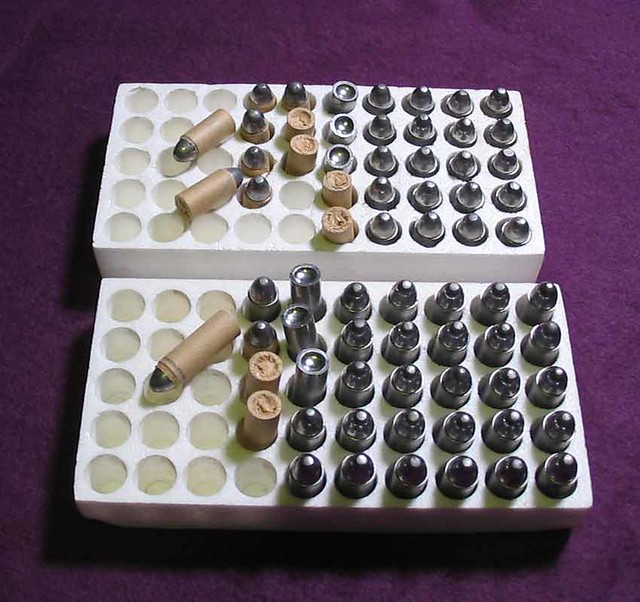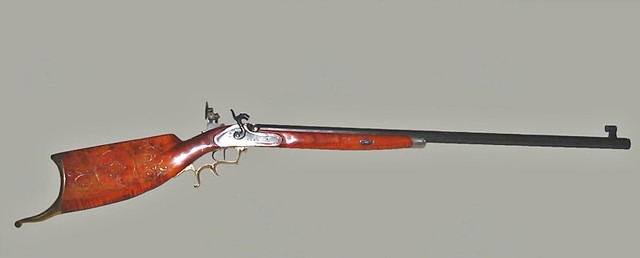-
Friends, our 2nd Amendment rights are always under attack and the NRA has been a constant for decades in helping fight that fight.
We have partnered with the NRA to offer you a discount on membership and Muzzleloading Forum gets a small percentage too of each membership, so you are supporting both the NRA and us.
Use this link to sign up please; https://membership.nra.org/recruiters/join/XR045103
You are using an out of date browser. It may not display this or other websites correctly.
You should upgrade or use an alternative browser.
You should upgrade or use an alternative browser.
paper patching bullets
- Thread starter vgorilla
- Start date

Help Support Muzzleloading Forum:
This site may earn a commission from merchant affiliate
links, including eBay, Amazon, and others.
ResearchPress
45 Cal.
Paper patching bullets is quite common practice for long range target shooting. I’ve used PP bullets for many years to good effect (match winning).
There’s a pictorial guide to paper patching on my web site. This shows patching with a ”˜wet patch’ - some patch ”˜dry’.
What rifle are you using?
David
There’s a pictorial guide to paper patching on my web site. This shows patching with a ”˜wet patch’ - some patch ”˜dry’.
What rifle are you using?
David
- Joined
- Jan 31, 2009
- Messages
- 13,026
- Reaction score
- 7,284

In a modified TC New Englander and rebarreled Renegade bench gun, they shoot better than I do.
With the years that have gone by I'm faced with needing glass to shoot accurately at longer range. I'm currently putting together a hunting rifle from the parts box, short barreled flinter Renegade to shoot the .519's. An ancient TC pistol scope, TC mount for octagonal barrels, L&R replacement lock.
Should be a hum dinger.
- Joined
- Jan 3, 2013
- Messages
- 20,091
- Reaction score
- 1,023
Idaho Ron is your man.....do a search or wait till he chimes in....he also has videos on youtube.
http://www.public.iastate.edu/~jessie/PPB/PPB.htm
the above is my buddy's web site on PP bullets.
Might be helpful to you.
Fleener
the above is my buddy's web site on PP bullets.
Might be helpful to you.
Fleener
Last edited by a moderator:
An Easy Wider kept the 45 caliber Lyman Minnie ball in the bore of my H&A 45 kit gun. Don't know the twist of the short barrel but it would group 2 inches at 50 yards.
Killed a couple deer and lent the Krylon camo sprayed kit out to others. It killed deer, bear and 1 moose cow.
It worked for me without the Minnie falling out of the barrel as it did before the wrap. After wrapping, I dunked it in microwaved TC bore butter.
Killed a couple deer and lent the Krylon camo sprayed kit out to others. It killed deer, bear and 1 moose cow.
It worked for me without the Minnie falling out of the barrel as it did before the wrap. After wrapping, I dunked it in microwaved TC bore butter.
- Joined
- Jan 31, 2009
- Messages
- 13,026
- Reaction score
- 7,284
.40 bore GPR.


- Joined
- Jan 31, 2009
- Messages
- 13,026
- Reaction score
- 7,284
Adjustable length mold for the .69 bore two bander.


.40 Caliber Schuetzen rifle and some PP bullets.




- Joined
- Jan 31, 2009
- Messages
- 13,026
- Reaction score
- 7,284
A TC fifty...
Had a cup of coffee just now and started chasing down a fun rabbit trail.
Paper patching was used almost two hundred years ago as a pretty good means of creating a faster rate of accurate fire for military long arms. To make .50 ammo you could scale down in size what some military muskets did, using bullets that with the paper patch will go down a fouled bore. Most likely with a hollow base on a bullet matched to the rate of twist. And a scheme for lubing the projectile has to be included somewhere, there being various ways to do it. 48" twist is actually not a fast twist for .50 caliber. There were military .58 calibers with 4' twist on up through 6' twist. A 3' twist in a .50 would be about like a 4' in the .58. So a TC .50 is more or less equivalent to and about like the average for military .58's.
Not having fired paper patched hollow based in a TC .50 I don't know. But it seems to me that it oughta be something that could be worked out and that it would be something along the lines of oh say, something about the same power level as Civil War era combat ammo.
Most everybody is usually thinking deer when such conversations come up but this has me thinking about recreational shooting. Makes me want to grab another cup and measure a TC bore.
Had a cup of coffee just now and started chasing down a fun rabbit trail.
Paper patching was used almost two hundred years ago as a pretty good means of creating a faster rate of accurate fire for military long arms. To make .50 ammo you could scale down in size what some military muskets did, using bullets that with the paper patch will go down a fouled bore. Most likely with a hollow base on a bullet matched to the rate of twist. And a scheme for lubing the projectile has to be included somewhere, there being various ways to do it. 48" twist is actually not a fast twist for .50 caliber. There were military .58 calibers with 4' twist on up through 6' twist. A 3' twist in a .50 would be about like a 4' in the .58. So a TC .50 is more or less equivalent to and about like the average for military .58's.
Not having fired paper patched hollow based in a TC .50 I don't know. But it seems to me that it oughta be something that could be worked out and that it would be something along the lines of oh say, something about the same power level as Civil War era combat ammo.
Most everybody is usually thinking deer when such conversations come up but this has me thinking about recreational shooting. Makes me want to grab another cup and measure a TC bore.
- Joined
- Jan 31, 2009
- Messages
- 13,026
- Reaction score
- 7,284
vgorilla,
Just go by the TC published .50 rifle data.
Just go by the TC published .50 rifle data.
Bent Sight
36 Cal.
Has anyone experimented with paper patching round balls?
That brown paper you see on those Schutzen bullets is dress pattern paper.jimbeilke said:What kind of paper do you use for your paper wraps?
It came from a dress pattern my wife didn't want so she "allowed" me to use it.
The paper is .001 thick and the bullets are wrapped with two layers.
Using a .395 diameter solid lead bullet those two layers add .004 to its diameter so it ends up being .399 when it's finished.
The paper is dampened with water before wrapping the bullet and tucking in the overhanging paper at the rear into the hollow cavity you can see in the pictures.
When the paper drys, it shrinks, making it skin tight on the slug.
I do not lubricate the paper until just before I load. Then, I lubricate the paper with a mixture of bees wax and Vaseline.
The long bullets you see in the lower box are 400 grains weight.
It never fails that when I'm shooting at the shooting range, someone comes up and looks at them and says, "Does that paper have the powder in it? It doesn't look like much of a powder charge."
When I answer, "No. That's just the bullet.", their eyes bulge a bit and their mouth hangs open. :rotf:
cannonball1
62 Cal.
- Joined
- Mar 11, 2014
- Messages
- 649
- Reaction score
- 506
I use the Chase method (single wrap) and I use 20 lb. computer paper. That being said I have found all 20 lb. is not the same thickness. One brand of 20 lb. was .0040 thickness and other brand was .0035 and believe me it does make a big difference. I size my bullets and the wad needs to go down the barrel the same time as the bullet to keep the paper from slipping. The tolerances seem to be more critical with this type of system. The bullet needs to slide down the barrel with some resistance, but not much. The last time at the range I got a 3 1/4" group at 300 yards on a bench.
Next time might not be that good.
As of this date I have not figured out the secret to get a good group with the double wrap system, but I'll keep trying.
Next time might not be that good.
As of this date I have not figured out the secret to get a good group with the double wrap system, but I'll keep trying.
Similar threads
- Replies
- 2
- Views
- 231
- Replies
- 0
- Views
- 58



